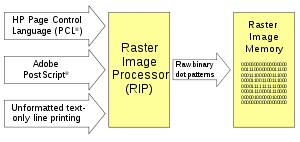Raster image processor

A raster image processor (RIP) is a component used in a printing system which produces a raster image also known as a bitmap. Such a bitmap is used by a later stage of the printing system to produce the printed output. The input may be a page description in a high-level page description language such as PostScript, Portable Document Format, XPS or another bitmap of higher or lower resolution than the output device. In the latter case, the RIP applies either smoothing or interpolation algorithms to the input bitmap to generate the output bitmap.
Originally RIPs were a rack of electronic hardware which received the page description via some interface (e.g. RS-232) and generated a "hardware bitmap output" which was used to enable or disable each pixel on a real-time output device such as an optical film recorder.
A RIP can be implemented either as a software component of an operating system or as a firmware program executed on a microprocessor inside a printer, though for high-end typesetting, standalone hardware RIPs are sometimes used. Ghostscript and GhostPCL are examples of software RIPs. Every PostScript printer contains a RIP in its firmware.
Earlier RIPs retained backward compatibility with photosetters so they supported the older languages. So, for example Linotype RIPs supported CORA (RIP30).
Stages of RIP
- Interpretation: This is the stage where the supported PDLs (Page description languages) are translated into a private internal representation of each page. Most RIPs process pages serially so the current machine state is only for the current page; i.e. one page at once. Once a page has been output the page state is discarded to ready it for the next page.
- Rendering: A process through which the private internal representation is turned into a continuous tone bitmap. Note that in practical RIPs, interpretation and rendering are frequently done together. Simple languages were designed to work on minimal hardware so tend to "directly drive" the renderer.
- Screening: In order to print, a continuous-tone bitmap is converted into a halftone (pattern of dots). Two screening methods or types are Amplitude Modulation (AM) screening and stochastic or Frequency Modulation (FM) screening. In AM screening, dot size varies depending on object density—tonal values; dots are placed in a fixed grid. In FM screening, dot size remains constant and dots are placed in random order to create darker or lighter areas of the image; dot placement is precisely controlled by sophisticated mathematical algorithms.
A RIP chip is used in laser printers to communicate raster images to a laser.
RIP Providers
- Caldera RIP and complementary software solutions for the wide format printing industry
- ColorGATE RIP Software and printer driver technology for the Commercial Printing (Digital, Conventional Printing, Prepress) and Industrial Printing
- EFI, Inc. EFI Fiery Controllers.
- EG-DocRIP (printer drivers not available) can interpret several printer languages or document formats - HP PCL5, XL, Adobe PostScript Level3, Microsoft XPS, W3C XHTML-MP, and render to raster image.
- ImageNest RIP (Non windows OS) can layout multiple raster and PostScript files onto a single page. File support includes EPS, PDF, PS (Postscript) Camera RAW, DNG, TIF, JPG, GIF, PNG, HDR (High Dynamic Range), and other formats.
- Harlequin RIP renders from PostScript, PDF, XPS, PCL etc. for use in desktop printers, digital production presses and prepress.
- RipExpress and PrintExpress Adobe CPSI based RIPs from IPA Systems Ltd.
- ImagePrint Windows / Macintosh RIP specializing in Fine Art and Photographic reproduction on Inkjet printers.
- Onyx RIP Products, Onyx Graphics
- Cadlink, RIP's for Direct To Garment, Large format and Film Separations
- ErgoSoft, Professional RIP and Workflow solutions
- TOSHIBA TEC is developing PCL, PS3 and XPS RIP and printer drivers inhouse for its e-BRIDGE based MFPs
- Serendipity Software RIP and colour management system built for photographers, designers and print professionals.